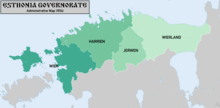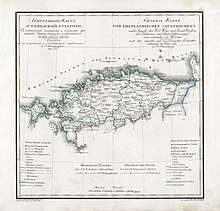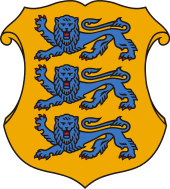Governorate of Estonia
The Governorate of Estonia[1] (also Esthonia;[2] German: Est(h)ländisches Gouvernement; Russian: Эстля́ндская губе́рния, romanized: Estljandskaja gubernija; Estonian: Eestimaa kubermang) was a governorate of the Russian Empire in what is now northern Estonia. It bordered the Livonian Governorate to the south and Saint Petersburg Governorate to the east.
| Governorate of Estonia Est(h)ländisches Gouvernement Эстля́ндская губе́рния Eestimaa kubermang | |||||||||
|---|---|---|---|---|---|---|---|---|---|
| Governorate of the Russian Empire | |||||||||
| 1721–1917 | |||||||||
 Governorate of Estonia | |||||||||
| Capital | Reval (present-day Tallinn) | ||||||||
| Population | |||||||||
• (1897) | 412716 | ||||||||
| History | |||||||||
• Established (de facto) | 9 June 1719 | ||||||||
• Established (de jure) | 10 September 1721 | ||||||||
• Renamed | 1796 | ||||||||
• Autonomy granted | 12 April 1917 | ||||||||
| Political subdivisions | 5 | ||||||||
| |||||||||
| Today part of | |||||||||

The Governorate was gained by the Russian Empire from Sweden during the Great Northern War in 1721.[3][4] The Russian Tsars held the title Duke of Estonia (Russian: Князь Эстляндский, Knjaz' Èstljandskij), during the Imperial Russian era in English sometimes also referred to as Prince of Estonia.[5]
Until the late 19th century the governorate was administered independently by the local Baltic German nobility through a feudal Regional Council (German: Landtag).[6]
History
Initially named the Reval Governorate after the city of Reval (today known as Tallinn), the Governorate originated in 1719 from territories which Russia conquered from Sweden in the course of the Great Northern War of 1700-1721. Sweden formally ceded its former dominion of Swedish Estonia to Russia in the Treaty of Nystad in 1721. During subsequent administrative reordering, the governorate was renamed in 1796 as the Governorate of Estonia. While the rule of the Swedish kings had been fairly liberal with greater autonomy granted for the peasantry, the regime tightened under the Russian tsars and serfdom was not abolished until 1819.
The governorate consisted the northern part of the present-day Estonia, approximately corresponding to: Harju, Lääne-Viru, Ida-Viru, Rapla, Järva, Lääne and Hiiu counties and a small portion of Pärnu County.
After the Russian February Revolution, on 12 April [O.S. 30 March] 1917) the governorate expanded to include northern Livonia, thereby forming the Autonomous Governorate of Estonia which existed less than a year, until February 1918.
Subdivisions
The governorate was subdivided into uyezds (German: Kreis).[7]
- Kreis Wierland – Wesenberg (now Rakvere)
- Kreis Jerwen – Weissenstein (now Paide)
- Kreis Harrien – Reval (now Tallinn; capital)
- Kreis Wiek – Hapsal (now Haapsalu; including the Dagö island)
- Kreis Baltischport – Baltischport (now Paldiski; 1783–1796)
Leaders of the governorate
- 1710–1711 Rudolph Felix Bauer – General-Governor
- 1711–1719 Prince Aleksandr Danilovich Menshikov – General-Governor
- 1719–1728 Count Fyodor Matveyevich Apraksin – General-Governor
- 1728–1736 Friedrich Freiherr von Löwen
- 1736–1738 Ernst Sebastian von Manstein
- 1738–1740 Gustaf Otto Douglas
- 1740–1743 Ulrich Friedrich Woldemar Graf von Löwendal
- 1743–1753 Peter August Friedrich, Duke of Schleswig-Holstein-Sonderburg-Beck (1696–1775)
- 1753–1758 Prince Vladimir Petrovich Dolgorukiy
- 1758–1775 Peter August Friedrich, Duke of Schleswig-Holstein-Sonderburg-Beck – General-Governor
- 1775–1792 Count George Browne – General-Governor
- 1783–1786 Georg Friedrich von Grotenhielm
- 1786–1797 Heinrich Johann Freiherr von Wrangell
- 1797–1808 Andreas von Langell
- 1808–1809 Duke Peter Friedrich Georg of Oldenburg
- 1809–1811 vacant
- 1811–1816 Duke Paul Friedrich August of Oldenburg
- 1816–1819 Berend Freiherr von Uexküll
- 1819–1832 Gotthard Wilhelm Freiherr von Budberg-Bönninghausen
- 1832–1833 Otto Wilhelm von Essen
- 1833–1841 Paul Friedrich von Benckendorff
- 1842–1859 Johann Christoph Engelbrecht von Grünewaldt
- 1859–1868 Wilhelm Otto Cornelius Alexander von Ulrich
- 1868–1870 Mikhail Nikolaiyevich Galkin-Vraskoy
- 1870–1875 Prince Mikhail Valentinovich Shakhovskoy-Glebov-Strezhnev
- 1875–1885 Viktor Petrovich Polivanov
- 1885–1894 Prince Sergey Vladimirovich Shakhovskoy
- 1894–1902 Yefstafiy Nikolaiyevich Skalon
- 1902–1905 Aleksey Valerianovich Bellegarde
- 16 March 1905 – October 1905 Aleksey Aleksandrovich Lopukhin
- 1905–1906 Nikolay Georgiyevich von Bünting
- 1906–1907 Pyotr Petrovich Bashilov
- 1907–1915 Izmail Vladimirovich Korostovets
- 1915–1917 Pyotr Vladimirovich Veryovkin
Language
- According to the Imperial census of 1897.[8] In bold are languages spoken by more people than the state language.
| Language | number | percentage (%) | males | females |
|---|---|---|---|---|
| Estonian | 365,959 | 88.67 | 176,972 | 188,987 |
| Russian | 20,439 | 4.95 | 12,441 | 7,998 |
| German | 16,037 | 3.88 | 6,991 | 9,046 |
| Swedish | 5,768 | 1.39 | 2,725 | 3,043 |
| Yiddish | 1,269 | 0.3 | 852 | 417 |
| Polish | 1,237 | 0.29 | 921 | 316 |
| Did not name their native language |
15 | >0.01 | 8 | 7 |
| Other[9] | 1,992 | 0.48 | 1,499 | 493 |
| Total | 412,716 | 100 | 202,409 | 210,307 |
 |
See also
- Administrative divisions of Russia in 1719-1725
- History of Estonia – Part of Imperial Russia
References
- The Baltic States from 1914 to 1923 By LtCol Andrew Parrott. Archived 19 March 2009 at the Wayback Machine
- William Henry Beable (1919), "Governments or Provinces of the Former Russian Empire: Esthonia", Russian Gazetteer and Guide, London: Russian Outlook
- Juan Pan-Montojo; Frederik Pedersen, eds. (2007). Communities in European History: Representations, Jurisdictions, Conflicts. Edizioni Plus. p. 227. ISBN 9788884924629.
- Bojtár, Endre (1999). Foreword to the Past. Central European University Press. ISBN 978-963-9116-42-9.
- Ferro, Marc; Brian Pearce (1995). Nicholas II. Oxford University Press US. p. 36. ISBN 978-0-19-509382-7.
- Smith, David James (2005). The Baltic States and Their Region. Rodopi. ISBN 978-90-420-1666-8.
- Эстляндская губерния (in Russian). Руниверс. Retrieved 22 December 2013.
- Language Statistics of 1897 (in Russian)
- Languages of which number of speakers in all Governorate were less than 1000
Further reading
- Sergey Plescheef (1792). "Northern Region: Government of Revel". Survey of the Russian Empire. Translated by James Smirnove (3rd ed.). London: J. Debrett – via Hathi Trust.CS1 maint: multiple names: authors list (link)

